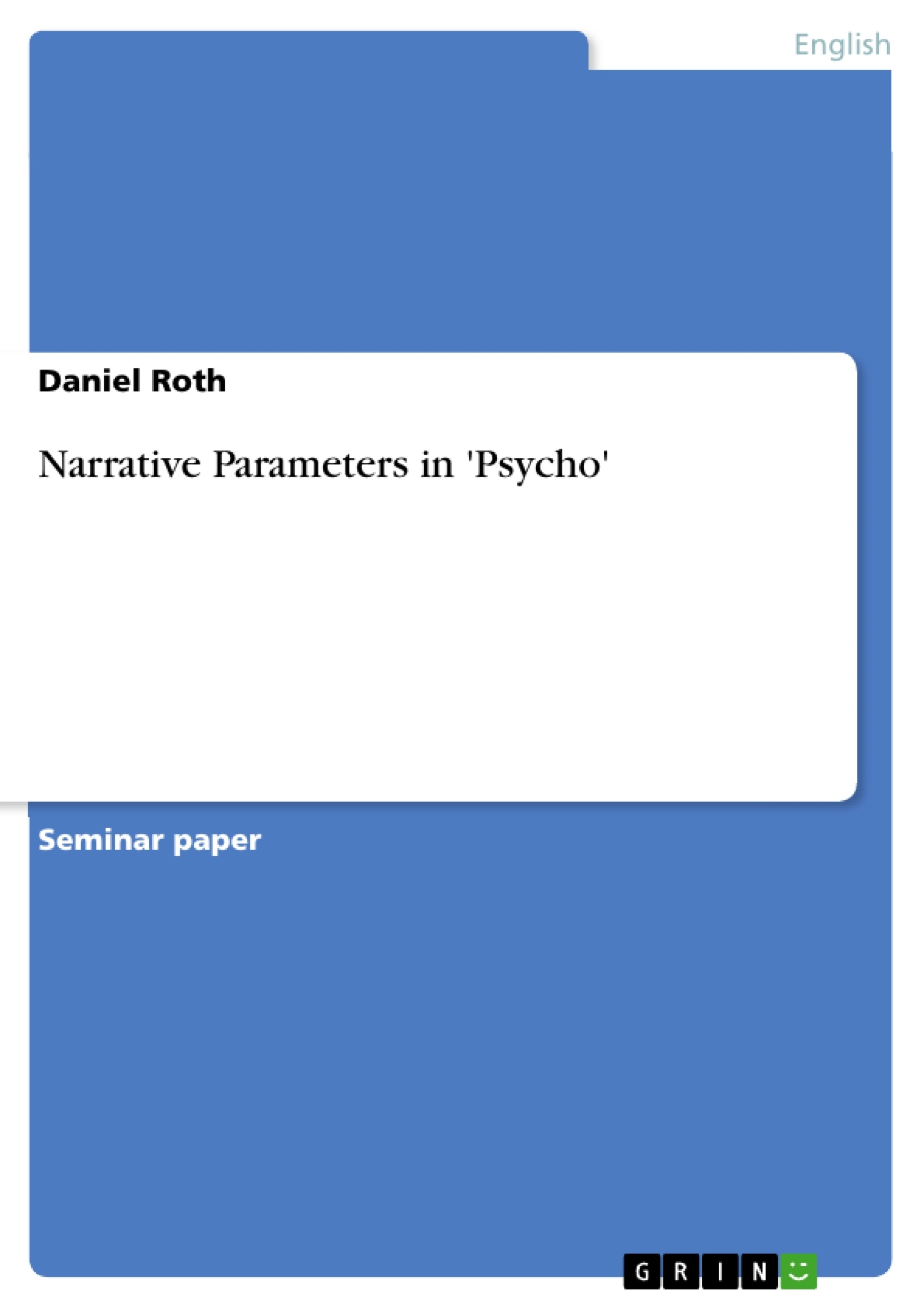1. Introduction
It was probably Psycho´s expressionistic interplay between music, mise en scène and story telling which remotely reminded me of Martin Scorsese´s Taxi Driver, a film I had written about before, that fostered my decision to write about the film that is by many considered to be Alfred Hitchcock´s masterpiece.
As a student of English literature I became quickly interested in the literary model of Psycho by Robert Bloch. It soon dawned on me that since the book is basically a piece of pulp fiction with considerably low literary value I would not be able to draw very profound interpretations out of it.
Hitchcock however had not adapted the book for its substance but for its structure which he had incorporated with some minor alterations almost identically into the film.
On my search for the structure of my paper a book by Vibeke Reuter called Alfred Hitchcocks Handschrift rose my attention. Her starting point basically is the question what constituted Hitchcock´s originality and in how far his filmic material differs from its literary models. With occasional references to the books she analyzes Hitchcock´s films according to ten different narrative parameters. These parameters cover a broad range of aspects and in terms of narration display a rather integral picture.
I adopted her structure but omitted the parameter of the “structure of time” since Hitchcock pretty much conformed with the novel`s chronology and the fact that some characters are in a way imprisoned by their past did not prove to be enough to form a whole subsection.
As far as she referred to Psycho in her book I have integrated her arguments into my own argumentation. Like her I have primarily concentrated on the 1960 film and only referred to the novel in order to elaborate on Hitchcock´s innovations or his fixations that were already laid out in the book. How he tells his version of the story, creates suspense and produces identificatory uneasyness shall be worked out.
.................
Subsections: Introduction, Peculiarities (Begebenheiten), Heterosexual Relationships, Evil, Guilt, The Gaze, Psychological Ideas, The Picture of State Authorities, Structure, Narrative Situation, Distribution of Knowledge, Language, Motifs and Symbols, Geometrical Patterns, Mirrors, Birds, Space, Characters, Places of Indefinition (Unbestimmtheitsstellen), Elements of Genre, Conclusion, Sources, Internet Sources
Inhaltsverzeichnis (Table of Contents)
- Introduction
- Peculiarities (Begebenheiten)
- Heterosexual Relationships
- Evil
- Guilt
- The Gaze
- Psychological Ideas
Zielsetzung und Themenschwerpunkte (Objectives and Key Themes)
This paper analyzes Alfred Hitchcock's film "Psycho", focusing on its thematic and stylistic elements and exploring the relationship between the film and its literary source, Robert Bloch's novel. The main objectives of the paper are to identify Hitchcock's distinct filmic style, analyze how he uses narrative techniques to create suspense and unease, and examine how he adapts and interprets the themes of the novel.
- Interplay of Music, Mise en Scène, and Story Telling
- Adaptation of Literary Models and Hitchcock's Unique Filmic Style
- Themes of Heterosexuality, Evil, Guilt, and the Gaze
- Psychological Ideas and the Portrayal of Mental Illness
- Exploration of Societal Power Structures and Morality
Zusammenfassung der Kapitel (Chapter Summaries)
- Introduction: This chapter sets the stage for the analysis by explaining the author's interest in "Psycho" and how they chose to approach the topic. It highlights the author's reliance on Vibeke Reuter's book "Alfred Hitchcocks Handschrift" as a framework for analyzing the film.
- Peculiarities (Begebenheiten): This chapter delves into the key thematic elements of the film, examining the portrayal of heterosexual relationships, the concept of evil and guilt, the role of the gaze, and the exploration of psychological ideas, particularly in relation to Norman Bates's mental state.
- Heterosexual Relationships: This section explores the dynamics of romantic relationships in the film, highlighting the troubled nature of Marion and Sam's relationship and the overarching theme of the controlling and oppressive mother.
- Evil: This section delves into the portrayal of evil in the film, focusing on Norman Bates as the embodiment of chaos and the idea that evil is a spectrum inherent in all individuals. The discussion examines the film's exploration of societal norms and the questioning of "us and them" morality.
- Guilt: This section examines the complex portrayal of guilt in "Psycho". The author explores the ambiguity surrounding Marion Crane's theft and the multifaceted nature of Norman Bates's character, who is both victim and perpetrator.
- The Gaze: This section delves into the use of voyeurism and the concept of the gaze as a tool for exploring power dynamics and madness in the film. The author specifically discusses the staging of Norman's voyeuristic gaze and the connection to Hitchcock's interest in theatrical elements.
- Psychological Ideas: This section examines the portrayal of Norman Bates's mental illness, focusing on the distinctions between psychosis and dissociative personality disorder and the way the film blends psychoanalytic concepts with then-current understanding of mental illness.
Schlüsselwörter (Keywords)
This paper focuses on the thematic and stylistic elements of Alfred Hitchcock's "Psycho", exploring themes of heterosexual relationships, evil, guilt, the gaze, and psychological ideas. Key concepts include voyeurism, suspense, mise en scène, Hitchcock's filmic style, and the adaptation of literary models. The paper also investigates the film's representation of mental illness, particularly the portrayal of Norman Bates's dissociative personality disorder.
- Quote paper
- Daniel Roth (Author), 2009, Narrative Parameters in 'Psycho', Munich, GRIN Verlag, https://www.grin.com/document/189160



